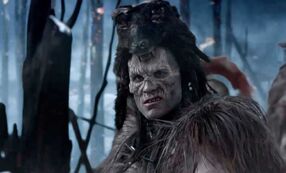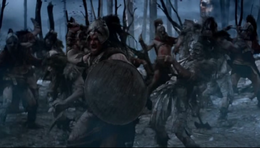The Getae are a Thracian Tribe

An example of a Getae warrior
located near the Black Sea. The Getae have a close relationship with both the Greeks and the Dacians.
The Getae were a formidable regional power during the First Century BCE, who lived in a series of fortified settlements known as "Davas", which were supported by a series of outlying farms and villages. From the early to middle First Century BCE, they were ruled by a powerful and ambitious king named Burebista, whom also presided over and promoted a henotheistic cult around the prophet-god Zalmoxis, who was reputed to be a man whom lived centuries ago, was taught by Greek philosophers such as Pythogoras and from Egyptian priests, before returning to his Thracian homeland and preaching the belief in spiritual immortality. Most Thracian kingdoms, however, believed in the traditional pantheon featuring the storm-god Gebeliezis (though Zalmoxis is thought have sometimes been equated with Gebeliezis).
In Getae (and indeed among other Thracian nations) there was a class of holymen called Ctistae, who according to Strabo (History VII:3

The Thracian squadron in battle against the Getae.
.3) were said to lead celibate lives. The Ctistae may have been to the Thracian people what the Druids were to the Celts.
The Getae/Dacians were divided into two main social casts: the nobles were called the Tarabostes, whom wore felt caps as to designate their higher social-status. While the lower class of people were recorded as the Comati.
Gold and silver-mining were important industries in Getae society until their conquest by the Romans under the Emperor Trajan in 106 CE.
Other tribal components of the main Getae nation include the Carpi, who dwelled east of the Carpathian Mountains (which may have been named for the them) in Moldavia and Wallachia. After the Roman conquest of the Dacian Kingdom in 106 CE, the Carpi would remain outside of Roman rule, and later join forces with the newly-arrived Germanic Goths in the early Third Century CE. There was also the Costoboci, found south of the Carpathian Mountains, whom are believed to have absorbed foreign Celtic and Sarmatian influences, or indeed, may have been composed of mixed Dacian and Celtic ancestry. And there were the Agathyrsi, found in Transylvania, who were believed to be the Thracianized descendants of formerly Scythian nomads whom settled in the region and became farmers.
In The Show[]
In the episode The Red Serpent, the Getae are the enemies of the Maedi Thracians, and allied to the Macedonians.
This would explain why Gnaeus, a Dacian, is so aggressive towards Spartacus, a Maedi Thracian. Dacians are descendants of the Getae, and long-time enemies of the Maedi.
The Getae, in the episode Red Serpent, are also depicted as rather stereotypical barbarians, being exclusively fur-clad and adorned with warpaint. In truth, the Getae were as cultured as their southern Thracian counterparts in the old Odrysian realm. In the centuries leading uo to the Third Mithridatic War, the Getae had been long exposed to influences from the Hellenistic states and the Celts, and were a highly-cultured people whom lived in large fortified towns (called davas), had a road system, and used the Greek alphabet. They also had access to bronze and chainmail armor. Their most formidable weapons were axes, and a long, curved hacking sword known as a Rhomphaia, which was widely used by other Thracian tribes. Similar weapon, called a Falx, also existed, but the hilts was longer than that of the Rhomphaia.